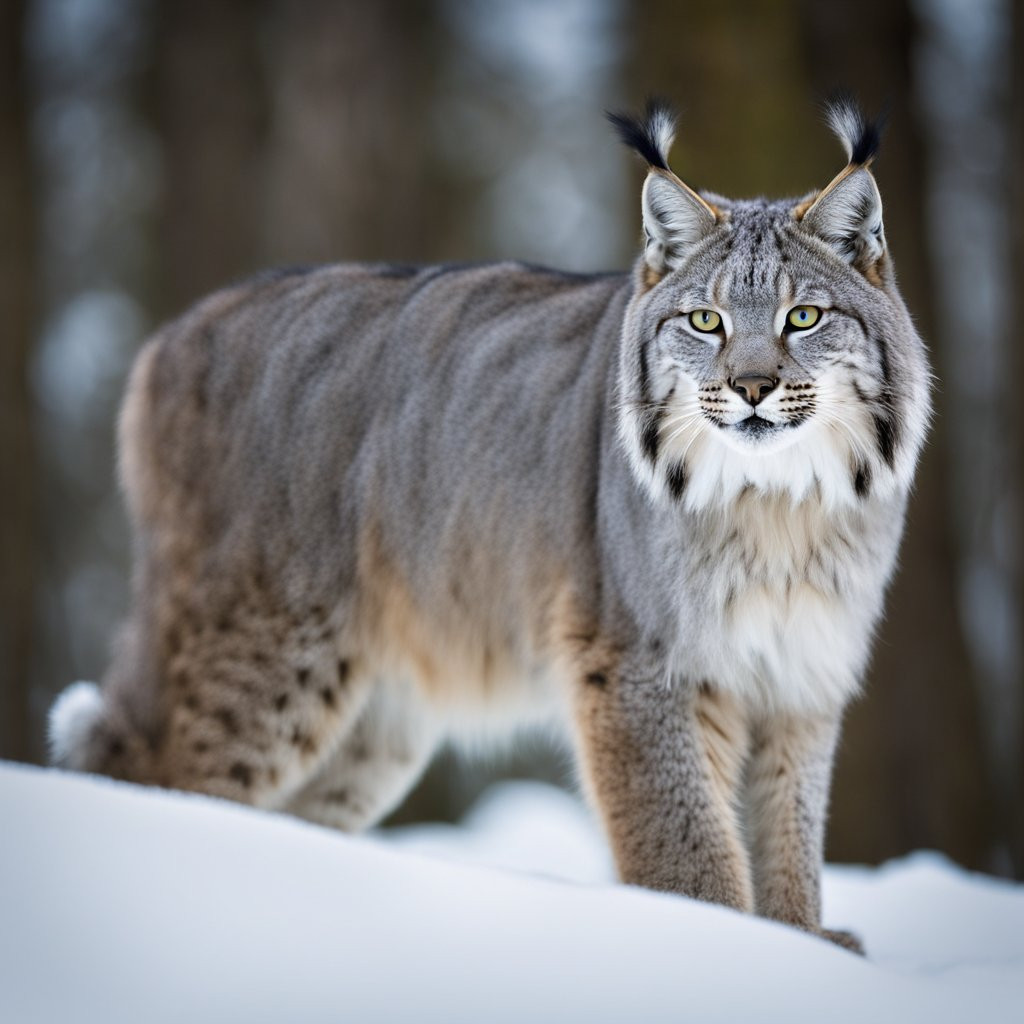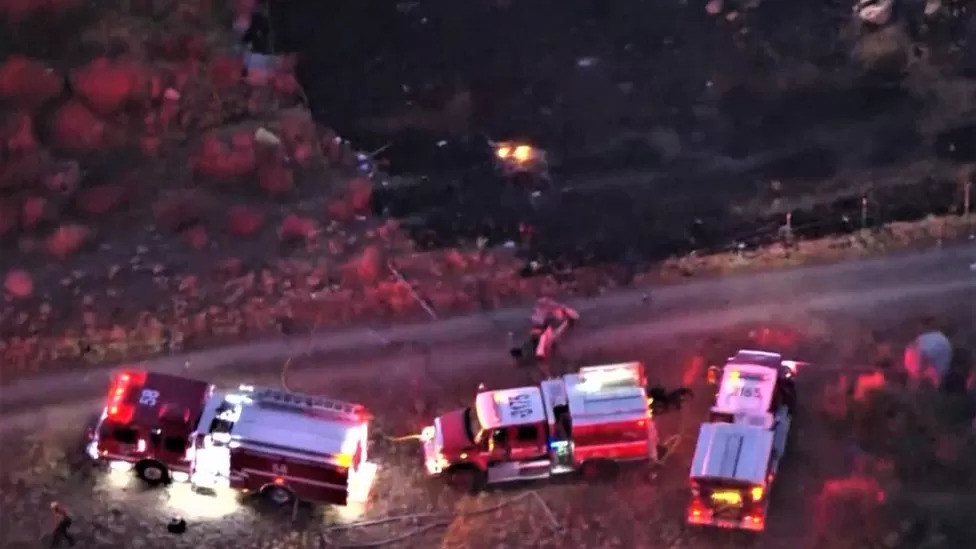A rare big cat native to Canada has been spotted in an unlikely place after a resident took a video of it in Southern Vermont. Last week, Shrewsbury resident Gary Shattuck took a video of a Canada lynx walking along the side of the road in Rutland County, marking the first time one of the cats has been confirmed in Vermont since 2018, according to the Vermont Fish and Wildlife Department.
Experts with Vermont Fish and Wildlife said Canada lynx are endangered in Vermont and threatened nationally, meaning the appearance of one of them in our region is a rare sight. Most confirmed Canada lynx sightings happen in the Northeast Kingdom, according to Brehan Furfey, wildlife biologist and furbearer project leader with the Vermont Fish and Wildlife Department. That's because conditions in the area support the best climate, habitat and food sources for the animal.
Canada lynx primarily hunt snowshoe hares, of which there are not many in Rutland County, Furfey said. Even so, Canada lynx are much more commonly seen in Maine and New Hampshire.
Furfey said he believes the lynx seen in the image was a male moving through the region looking to establish its own territory, which is a behavior called "dispersing." This behavior allows the cats to move quickly over long distances, meaning the animal could no longer be in Vermont.
"Although this lynx appears to be on the thinner side, its calm behavior around passing cars, as reported by observers, is not unusual for a dispersing individual," said Furfey. "This lynx was probably just focused on finding food in an area where hares are not abundant and on avoiding competition with bobcats and fishers while passing through southern Vermont."
While there have been more than 160 reports of lynx in Vermont, only seven of them have actually been confirmed by the department. The most recent confirmed report was in Jericho in 2018.
Furfey said if you think you have seen a lynx, you should send a photo or video to the Fish and Wildlife Department so it can be verified.
A Rare Sight in Vermont
The lynx was seen walking along a road in Rutland County on Aug. 17 and was recorded on video by several residents, said Brehan Furfey, a wildlife biologist with the department, in the Wednesday press release.
Canada lynx are endangered in Vermont and threatened — meaning likely to become endangered — in the United States.
Their endangered status has made lynx rare to spot in Vermont, Furfey said. Between 2016 and 2018, the state department recorded only seven confirmed reports of the species. The most recent credible report came from Jericho in 2018, according to the press release.
Lynx are similar to bobcats in size and appearance, according to the press release, and are often mistaken for each other. But lynx have distinguished black tail tips and light-colored heels, in contrast to bobcats’ white and black banded tail tips and black heels.
Canada lynx can be found across most of Canada and Alaska and parts of the northern United States, according to a report from the U.S. Fish and Wildlife Service. Populations persist in areas with deep snow and large tracts of dense forest, including in northern areas of Maine, New Hampshire, Minnesota, Montana and Washington. But timber harvest and recreational land use have led to habitat loss for lynx across the country, according to the federal department.
Vermont is on the southernmost edge of the lynx’s range, according to the press release. Most confirmed sightings have been in the Northeast Kingdom, which has the best climate, habitat and food sources for lynx in the state.
Furfey is the project leader for Vermont’s furbearer conservation and management project, which seeks to protect seventeen mammal species — including lynx — that have historically been hunted for their fur, according to a 2022 project report.
The project manages furbearer populations by conserving habitat, minimizing the impacts of human development on wildlife, and running regulated trapping and tracking programs. Overall, “the future presence of lynx in Vermont will depend on maintaining habitat connectivity between Vermont, New Hampshire, and Canada and mitigating the effects of climate change,” according to the report.
Rutland County is not a suitable habitat for lynx, mainly because the species’ main food source, snowshoe hare, do not appear in large numbers in the area, according to the press release. Instead, Furfey said, the reported lynx was likely just passing through the area while looking for a place to establish its own territory.
“Although this lynx appears to be on the thinner side, its calm behavior around passing cars as reported by observers is not unusual for a dispersing individual,” Furfey said in the press release. “This lynx was probably just focused on finding food in an area where hares are not abundant and on avoiding competition with bobcats and fishers while passing through southern Vermont.”
Furfey said that if Vermonters think they have found a lynx, they should take as many photos and videos as they can and send them to the state Fish and Wildlife Department.
“The large majority of photographs our biologists receive are bobcats, but that doesn’t exclude the possibility that a Canada lynx will show up one day,” she said.
Why This Sight Is So Rare
In an extraordinary and rare event, the Canada lynx, an elusive and endangered species in Vermont, was spotted in Rutland County on August 17, 2024.
Several residents captured the majestic wild cat on video as it walked along a road, marking the first confirmed sighting of a Canada lynx in Vermont in six years.
The Canada lynx is known for its elusive nature and is rarely seen in Vermont due to habitat loss and its endangered status. The species typically thrives in regions with deep snow and dense forest cover, which provides the perfect environment for their primary prey, the snowshoe hare.
According to Brehan Furfey, a wildlife biologist with the Vermont Fish and Wildlife Department, sightings of the Canada lynx have been incredibly scarce in recent years. "Between 2016 and 2018, we only recorded seven confirmed reports of lynx in Vermont," Furfey said in the department’s press release. The last credible sighting occurred in Jericho in 2018, and until this recent encounter, there had been no further confirmed sightings of the species in the state.
The Canada lynx can be difficult to distinguish from the more commonly seen bobcat. While similar in size and appearance, lynx have distinct features, including black tail tips and light-colored heels, which differentiate them from bobcats’ white and black banded tail tips and black heels. These physical traits often cause confusion among residents, with many bobcats being mistakenly identified as lynx.
The Canada lynx faces numerous challenges in Vermont, particularly due to the loss of habitat resulting from timber harvesting and recreational land use. These factors have contributed to a dramatic decline in lynx populations across the United States. The species’ range includes much of Canada, Alaska, and parts of the northern United States, including Maine, New Hampshire, Montana, and Washington. However, Vermont is located at the southernmost edge of the lynx's habitat range, which makes the state a less-than-ideal environment for the species.
Furfey, who leads Vermont’s furbearer conservation and management project, explained that the future of the lynx in Vermont hinges on the preservation of habitat connectivity between the state and its neighboring regions. "The future presence of lynx in Vermont will depend on maintaining habitat connectivity between Vermont, New Hampshire, and Canada and mitigating the effects of climate change," Furfey said.
The state’s conservation project focuses on protecting seventeen mammal species, including the Canada lynx, by conserving their habitats, minimizing the impacts of human development, and managing populations through regulated tracking and trapping programs.
The Future of the Canada Lynx in Vermont
Despite these efforts, Rutland County is not considered a suitable habitat for lynx due to the lack of snowshoe hares, the lynx’s primary food source. According to Furfey, "This lynx was likely just passing through the area while looking for a place to establish its own territory." She noted that while the animal appeared to be on the thinner side, it exhibited calm behavior when near passing cars, which is not uncommon for a lynx that is dispersing through unfamiliar territory in search of food.
The rare sighting of a Canada lynx in Vermont has reignited interest in the species’ conservation and has underscored the importance of continued efforts to preserve their habitat. The Northeast Kingdom of Vermont is home to the most suitable climate and environment for lynx in the state, offering the dense forests and deep snow that the species requires for survival. While sightings in other parts of Vermont, like Rutland County, are rare, conservationists remain hopeful that efforts to protect and connect habitats across state lines will help bolster the species' numbers.
"Although lynx are rare in Vermont, the possibility of spotting one is always present," Furfey said. She encourages residents who believe they have seen a lynx to document the encounter as thoroughly as possible by taking photos and videos and submitting them to the Vermont Fish and Wildlife Department for verification. "The large majority of photographs our biologists receive are bobcats, but that doesn’t exclude the possibility that a Canada lynx will show up one day," she added.
Moving forward, conservationists are focused on creating a balance between protecting wildlife habitats and addressing the effects of climate change, which threatens the long-term survival of species like the Canada lynx. With continued research, habitat management, and public awareness, there is hope that this rare and magnificent wild cat will once again establish a stable population in Vermont.

















